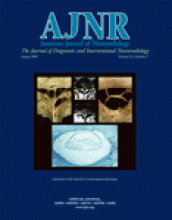Research ArticleNeurointervention
Visualization of Intraaneurysmal Flow Patterns with Transluminal Flow Images of 3D MR Angiograms in Conjunction with Aneurysmal Configurations
Toru Satoh, Keisuke Onoda and Shoji Tsuchimoto
American Journal of Neuroradiology August 2003, 24 (7) 1436-1445;
Toru Satoh
aDepartment of Neurological Surgery, Ryofukai Satoh Neurosurgical Hospital, Hiroshima, Japan
Keisuke Onoda
bDepartment of Neurological Surgery, Onomichi Municipal Hospital, Hiroshima, Japan
Shoji Tsuchimoto
bDepartment of Neurological Surgery, Onomichi Municipal Hospital, Hiroshima, Japan

References
- ↵
- ↵Gonzalez CF, Cho YI, Ortega V, et al. Intracranial aneurysms: flow analysis of their origin and progression. AJNR Am J Neuroradiol 1992;13:181–188
- ↵Gobin YP, Counord JL, Flaud P, et al. In vitro study of haemodynamics in a giant saccular aneurysm model: influence of flow dynamics in the parent vessel and effects of coil embolization. Neuroradiology 1994;36:530–536
- Burleson AC, Strother CM, Turitto VT. Computer modeling of intracranial saccular and lateral aneurysms for the study of their hemodynamics. Neurosurgery 1995;37:774–784
- ↵Tenjin H, Asakura F, Nakahara Y, et al. Evaluation of intraaneurysmal blood velocity by time-density curve analysis and digital subtraction angiography. AJNR Am J Neuroradiol 1998;19:1303–1307
- ↵Ujiie H, Tachibana H, Hiramatsu O, et al. Effects of size and shape (aspect ratio) on the hemodynamics of saccular aneurysms: a possible index for surgical treatment of intracranial aneurysms. Neurosurgery 1999;45:119–130
- ↵Tateshima S, Murayama Y, Villablanca JP, et al. Intraaneurysmal flow dynamics study featuring an acrylic aneurysm model manufactured using a computerized tomography angiogram as a mold. J Neurosurg 2001;95:1020–1027
- ↵Maeder PP, Meuli RA, de Tribolet N. Three-dimensional volume rendering for magnetic resonance angiography in the screening and preoperative workup of intracranial aneurysms. J Neurosurg 1996;85:1050–1055
- ↵
- ↵Adams WM, Laitt RD, Jackson A. The role of MR angiography in the pretreatment assessment of intracranial aneurysms: a comparative study. AJNR Am J Neuroradiol 2000;21:1618–1628
- ↵Watanabe Z, Kikuchi Y, Izaki K, et al. The usefulness of 3D MR angiography in surgery for ruptured cerebral aneurysms. Surg Neurol 2001;55:359–364
- ↵Satoh T. Transluminal imaging with perspective volume rendering of computed tomographic angiography for the delineation of cerebral aneurysms. Neurol Med Chir (Tokyo) 2001;41:425–430
- ↵Satoh T. Delineation of cerebral aneurysms with transluminal imaging of three-dimensional MR angiography. No Shinkei Geka (Tokyo) 2001;29:951–959 [in Japanese with English abstract]
- ↵Winn HR, Almaani WS, Berga SL, et al. The long-term outcome in patients with multiple aneurysms: incidence of late hemorrhage and implications for treatment of incidental aneurysms. J Neurosurg 1983;59:642–651
- ↵Wiebers DO, Whisnant JP, Sundt TM Jr, et al. The significance of unruptured intracranial saccular aneurysms. J Neurosurg 1987;66:23–29
- Asari S, Ohmoto T. Natural history and risk factors of unruptured cerebral aneurysms. Clin Neurol Neurosurg 1993;95:205–214
- Rinkel GJE, Djibuti M, Algra A, et al. Prevalence and risks of rupture of intracranial aneurysms: a systemic review. Stroke 1998;29:251–256
- International Study of Unruptured Intracranial Aneurysms Investigators. Unruptured intracranial aneurysms: risk of rupture and risks of surgical intervention. N Engl J Med 1998;340:1439–1442
- ↵Juvela S, Porras M, Poussa K. Natural history of unruptured intracranial aneurysms: probability of and risk factor for aneurysm rupture. J Neurosurg 2000;93:379–387
- Tsutsumi K, Ueki K, Morita A, et al. Risk of rupture from incidental cerebral aneurysms. J Neurosurg 2000;93:550–553
- ↵Weir B, Disney L, Karrison T. Size of rupture and unruptured aneurysms in relation to their sites and the age of patients. J Neurosurg 2002;96:64–70
- ↵Kerber CW, Imbesi SG, Knox K. Flow dynamics in a lethal anterior communicating artery aneurysm. AJNR Am J Neuroradiol 1999;20:2000–2003
- ↵Meyer FB, Huston J III, Riederer SS. Pulsatile increase in aneurysm size determined by cine phase-contrast MR angiography. J Neurosurg 1993;78:879–883
- ↵Benndorf G, Wellnhofer E, Lanksch W, et al. Intraaneurysmal flow: evaluation with Doppler guidewires. AJNR Am J Neuroradiol 1996;17:1333–1337
- ↵Sevick RJ, Tsuruda JS, Schmalbrock P. Three-dimensional time-of-flight MR angiography in the evaluation of cerebral aneurysms. J Comput Assist Tomogr 1990;14:874–881
- ↵Isoda H, Ramsey RG, Takehara Y, et al. MR angiography of aneurysm models of various shapes and neck sizes. AJNR Am J Neuroradiol 1997;18:1463–1472
- ↵Kato T, Indo T, Yoshida E, et al. Contrast-enhanced 2D cine phase MR angiography for measurement of basilar artery blood blow in posterior circulation ischemia. AJNR Am J Neuroradiol 2002;23:1346–1351
In this issue
Advertisement
Toru Satoh, Keisuke Onoda, Shoji Tsuchimoto
Visualization of Intraaneurysmal Flow Patterns with Transluminal Flow Images of 3D MR Angiograms in Conjunction with Aneurysmal Configurations
American Journal of Neuroradiology Aug 2003, 24 (7) 1436-1445;
0 Responses
Jump to section
Related Articles
- No related articles found.
Cited By...
- Usefulness of high-resolution three-dimensional proton density-weighted turbo spin-echo MRI in distinguishing a junctional dilatation from an intracranial aneurysm of the posterior communicating artery: a pilot study
- Visualization of Aneurysmal Neck and Dome after Coiling with 3D Multifusion Imaging of Silent MRA and FSE-MR Cisternography
- Aneurysm outflow angle at MRA as discriminant for accurate diagnosis and differentiation between small sidewall cerebral aneurysms and infundibula
- Identification of the Inflow Zone of Unruptured Cerebral Aneurysms: Comparison of 4D Flow MRI and 3D TOF MRA Data
This article has not yet been cited by articles in journals that are participating in Crossref Cited-by Linking.
More in this TOC Section
Similar Articles
Advertisement











